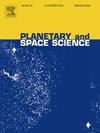基于形态测量结果的尼加尔山谷(火星)演化:构造作用起作用吗?
IF 1.7
4区 物理与天体物理
Q3 ASTRONOMY & ASTROPHYSICS
引用次数: 0
摘要
700公里长的尼尔加尔山谷是火星南半球独特的山谷之一。河状山谷的集水区可能形成于赫斯佩里时期(3000-3700 Ma前),随着时间的推移,受到许多影响。这项研究的目的是探索和分离这些潜在的影响,包括乌兹布伊山谷的水位变化,它的侵蚀基地。另一个目的是探测和描述构造过程的影响,因为我们已经发现了潜在的证据。我们的工作假设是Nirgal Vallis曾经是一个河谷:我们的研究分析了这种可能性。火星的气候在过去经历了剧烈的变化,液态水目前在火星表面并不稳定。活跃湿润期后,包括尼加尔山谷在内的前河谷的形成仍在继续。基于MOLA、THEMIS和HiRISE数据应用形态测量技术。本文通过河道分析、各种地貌参数的计算和径流模型对尼加尔河谷的地形进行了分析。详细分析使用了HiRISE立体像衍生的分米尺度分辨率的HiRISE数字地形模型。根据尼加尔河谷的构造地貌构造,建立了尼加尔河谷的分区。从河道分析和径流模型计算可以看出,虽然河谷目前没有严格的坡度,即目前没有水流下,但河谷确实有沿全长的坡度趋势,甚至在整个河谷可以观察到间歇性的坡度变化。利用MOLA数据还确定了几个小尺度的形态特征。我们得出的结论是,构造过程改变了河床的形态:它被分成小段(封闭盆地),因此目前的水不能在其中流下。地外因素(即来自火星外部的影响)对火星也有影响,即大大小小的陨石坑的形成也在地形上留下了印记。我们将尼尔加尔山谷周围高原上的亚垂直细长形态特征解释为褶皱脊:它们的大小、形状和间距与其他地方的作者发现的相似。我们还发现证据表明,山谷底部也被形成褶皱脊的过程所改变。我们的观察表明,该地区的构造影响较年轻,可能是在河流侵蚀制度之后。位于Nirgal Vallis和Uzboi Vallis汇合处附近的Luki陨石坑也被分析过,并发现了构造改变的证据。这一修正与其他有关尼加尔山谷构造影响的分析结果一致。我们的研究结果也可能对Uzboi山谷的形成产生影响,尽管这需要进一步的研究。这些结果表明,尼加尔山谷地区曾经形成了一个真正的山谷,具有类似陆地的水文特性,但由于液态水从该地区消失,地形已经改变,山谷可能受到长期或反复的构造影响。本文章由计算机程序翻译,如有差异,请以英文原文为准。
The evolution of Nirgal Vallis (Mars) based on morphometric results: does tectonics play a role?
One of the unique valleys in the southern hemisphere of Mars is the 700 km long Nirgal Vallis. The catchment area of the river-like valley, presumably formed in the Hesperian period (3000–3700 Ma ago), has been shaped over time by many influences. The goal of this study is to explore and separate these potential influences including changes in the water level of the Uzboi Vallis, its erosion base. The other aim is to detect and describe the effects of tectonic processes for we have found potential evidence. Our working hypothesis is that Nirgal Vallis was once a river valley: our study analyses this possibility. The climate of Mars has undergone drastic changes in the past, and liquid water is currently not stable on the surface. The formation of former river valleys after the active wet period continued, including Nirgal Vallis. Morphometric techniques were applied based on MOLA, THEMIS, and HiRISE data. The topography of the Nirgal Vallis have been analyzed by swath analysis, calculation of various geomorphometric parameters, and runoff model. HiRISE digital terrain models having decimeter-scale resolution derived from the HiRISE stereopairs have been used for the detailed analysis.
A subdivision of the Nirgal Vallis according to its tectonic geomorphological structures was established. The swath analysis and the runoff model calculation show that, although the valley does not have a strict thalweg today, i.e., water currently cannot flow down it, the valley does have a trend of slope along the whole length and even intermittent slope changes can be observed along the whole valley. Several small-scale morphological features were also identified using MOLA data.
We conclude that the tectonic processes have transformed the morphology of the riverbed: it is divided into small sections (closed basins) so that currently water would not be able to flow down in it. Extraterrestrial (i.e. effects from outside Mars) causes on Mars also influence this, i.e. the formation of larger and smaller craters has also left its mark on the topography. We interpret the subperpendicular elongated morphological features on the plateau surrounding Nirgal Vallis as wrinkle ridges: their size, shape and spacing is similar to those identified by previous authors elsewhere. We also found evidence that the valley bottom has also been modified by the processes that formed the wrinkle ridges. Our observations imply younger tectonic influence of the area, presumably, postdating the fluvial erosional regime.
The Luki Crater, located near the confluence of Nirgal Vallis and Uzboi Vallis, has also been analyzed, and evidence has been found to be tectonically modified. This modification is in congruence with the results of other analyses indicating tectonic influence of Nirgal Vallis. Our results may also have implications for formation of the Uzboi Vallis, though this will require further studies.
These results suggest that the area of the Nirgal Vallis once formed a real valley with terrestrial-like hydrological properties, but since the liquid water disappeared from the area, the thalweg has been modified and the vallis was exposed to presumably longer-term or repeated tectonic influences.
求助全文
通过发布文献求助,成功后即可免费获取论文全文。
去求助
来源期刊

Planetary and Space Science
地学天文-天文与天体物理
CiteScore
5.40
自引率
4.20%
发文量
126
审稿时长
15 weeks
期刊介绍:
Planetary and Space Science publishes original articles as well as short communications (letters). Ground-based and space-borne instrumentation and laboratory simulation of solar system processes are included. The following fields of planetary and solar system research are covered:
• Celestial mechanics, including dynamical evolution of the solar system, gravitational captures and resonances, relativistic effects, tracking and dynamics
• Cosmochemistry and origin, including all aspects of the formation and initial physical and chemical evolution of the solar system
• Terrestrial planets and satellites, including the physics of the interiors, geology and morphology of the surfaces, tectonics, mineralogy and dating
• Outer planets and satellites, including formation and evolution, remote sensing at all wavelengths and in situ measurements
• Planetary atmospheres, including formation and evolution, circulation and meteorology, boundary layers, remote sensing and laboratory simulation
• Planetary magnetospheres and ionospheres, including origin of magnetic fields, magnetospheric plasma and radiation belts, and their interaction with the sun, the solar wind and satellites
• Small bodies, dust and rings, including asteroids, comets and zodiacal light and their interaction with the solar radiation and the solar wind
• Exobiology, including origin of life, detection of planetary ecosystems and pre-biological phenomena in the solar system and laboratory simulations
• Extrasolar systems, including the detection and/or the detectability of exoplanets and planetary systems, their formation and evolution, the physical and chemical properties of the exoplanets
• History of planetary and space research
 求助内容:
求助内容: 应助结果提醒方式:
应助结果提醒方式:


